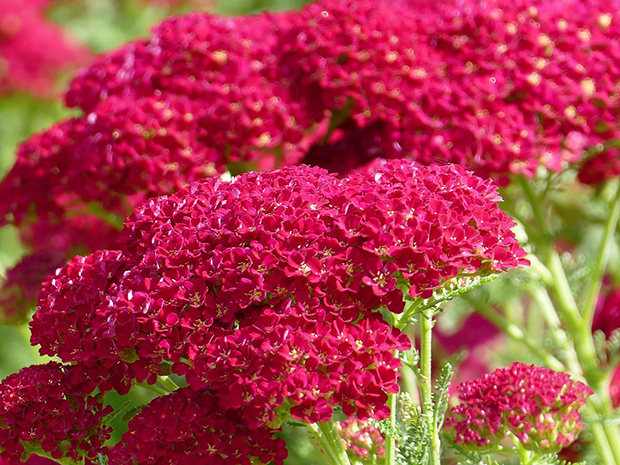Achillea
Better known as yarrow, achillea has many advantages. This is one tough and tolerant plant. Growing to between 1.5′ and 3′, yarrow isn’t very picky about soil conditions, can weather dry conditions and multiplies without any help at all. The traditional yarrow has yellow flowers, but available varieties come in pinks and red as well. If you’re looking for low to no maintenance and a long blooming plant yarrow is for you. It’s also famous for being easily dried and used for indoor decoration. Try ‘Strawberry Seduction’ for bold red flowers.
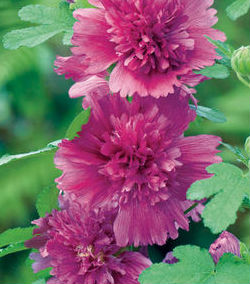 Alcea
Alcea
Hollyhocks are a quintessential garden flower having been grown in the cottage garden for hundreds of years. Rising from the ground to several feet, this display is spectacular. After May and June bloomers pass, you’ll be rewarded with a show worth waiting for.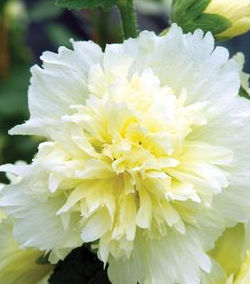
Hollyhocks re-seed themselves reliably, so although not a standard perennial in the strictest sense, they will be back each season enjoying a sunny place near a fence or shed wall. The standard hollyhocks are some of the tallest flowers in the garden with some varieties topping out at 8 feet!
Both hummingbirds and butterflies will find an abundance of flowers waiting for them. Pictured are two colors from the ‘Spring Celebrities’ series, a more compact variety, with fluffy and large double blooms standing 3-4′. These shorter hollyhocks are perfect for a summer border or even containers that will stay in color through early fall.
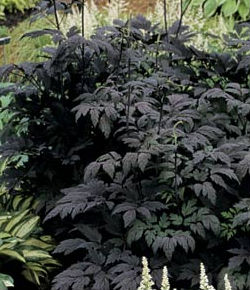 Cimicifuga
Cimicifuga
Happily, this is a plant for late summer blooms in the shade garden, although cimicifuga can take some sun as long as it’s protected from the strongest sun of the day. Impressive cut foliage gives way to tall white or pinkish flower spikes topping out at 4-5′. Prized for its foliage, cimicifuga range from green to almost black, with the dark purple/black varieties being the most popular. You can’t beat it for texture, color contast and drama when planted with hosta or forest grass. Cimicifuga is one of the lastest plants to bloom and may even flower into November! We recommend ‘Brunette’ and ‘Black Negligee’ for great foliage.
 Coreopsis
Coreopsis
Coreopsis are about as reliable as perennials can be and also fit into the long blooming category. With a simple shearing in the high heat days, they’ll come back to continue blooming into the fall.
There is a lot of variety within the coreopsis group. From pure yellow to red and in-between bi-color flowers, this plant is a consistant bloomer that also brings airy foliage to the garden.
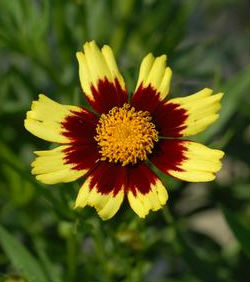
Different heights are also available making it suitable for border, mid-border and background areas.
Plant coreopsis in full sun and don’t fret over soil quality too much. As long as the soil drains well, coreopsis can withstand some drought and will multiply itself happily. Good as a cut flower too, you won’t be sorry you added coreopsis to your garden. Pictured on the left is ‘Zagreb’ and on the right a member of the ‘Big Bang’ series with bi-color flowers.
 Echinacea
Echinacea
Coneflowers seem to be the celebrity of plants during the past few years. So many varieties in so many forms have emerged on the market, that you could almost plant only coneflowers and still enjoy enough color and form to feel your garden is complete. Colors range from white, white & green, green & pink to many pinks, oranges and magentas. Heights vary greatly now as do flowers shapes with fat petals, thin petals and flowers that look like badminton shuttlecocks.
Originally a sturdy prairie plant, coneflowers haven’t lost any of their toughness with the new varieities. Full sun is the best spot to plant one, but they’ll tolerate a bit of shade as well. Once established they are fully reliable and give you a great show from mid-summer to first frost. Deadheading is recommended to keep them blooming. Pictured is ‘Pow Wow Wildberry’, but for a stunning orange display, try ‘Tomato Soup’.
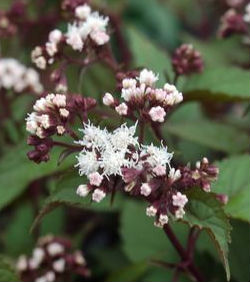 Eupatorium
Eupatorium
Joe Pye weed is one of the tallest of the garden flowers. 4 to 6′ is not unusual. The foliage is pleasing and gives way to big puffy flowers in late summer. Plant it in full or part sun and stand back! You’ll be amazed at the size of Joe Pye. When planting, make sure you have a spot that will give it space to grow into over time. Use it as a background to other garden perennials.
Joe Pye weed likes moist soil that is rich and well-draining and will not be pleased with a spot that becomes dry. Very easy with regular deep watering. A layer of mulch will help keep the roots moist.
For not as tall varieties, check out ‘Chocolate’ with dark purple leaves turning green, and ‘Pink Frost’, with great leaf variegation.
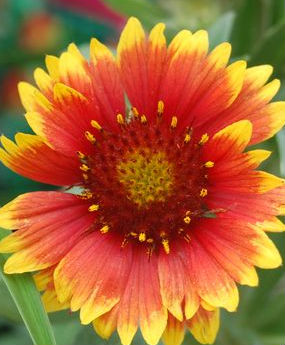 Gaillardia
Gaillardia
Full sun is the ticket for this perennial that turns its face upward toward the rays. Gaillardia is a shorter plant with a big impact. Any border or rock garden that can use a splash of hot color would look great with gaillardia ‘Arizona Sun’ or ‘Arizona Red Shades’.
The parentage of this plant is a match up between a native Southwestern gaillardia and a prairie cultivar, so you can quite literally bring that Southwest feel to a hot strip of garden. As a bonus, gaillardia won’t be too happy with rich soil.
Gaillardia requires a modest amount of deadheading, but it’s well worth it. As you see the last flowers of the season, continue to deadhead if you don’t want more gaillardias nearby next season as this flower will re-seed. The goldfinches will thank you if you let this one “go to seed”.
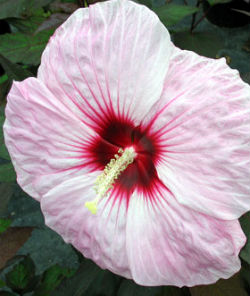 Hardy Hibiscus
Hardy Hibiscus
Perennial hibiscus, also referred to as rose mallow, are positively stupendous. Big faced flowers in bold colors standing on 4-5′ stems can’t help but demand attention in the summer months. Just try to look away! This is drama and color at its best! Easy to grow, just watch them take off! Plant hardy hibiscus in full sun.
Pictured on the left is ‘Kopper King’, and ‘Heartthrob’ looking great on the right.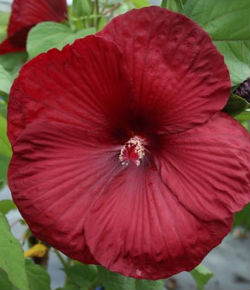
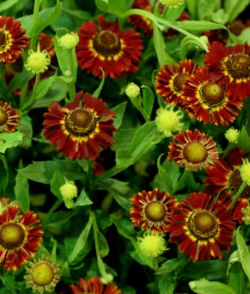 Helenium
Helenium
Named after Helen of Troy, Helen’s flower was said to have grown where her tears touched the ground. Helenium’s blooms come in a range of yellows and reds with a very interesting button top with petals fanning out below, in the shape of a sunhat.
Blooming begins in mid-summer and continues to fall with faithful deadheading. Helenium grows to 2-3′ but shearing back in early summer can shorten the habit for the season. If you are a gardener who continually battles deer and rabbits, this is the perennial for you. Helenium is toxic to both and they’ll steer clear of this pretty flower.
While helenium is heat and drought tolerant it can also withstand damp soil, so plant it in a low spot if you like. This is a carefree native plant.
‘Salsa’ is pictured with rich red petals sporting some yellow accents around the bases and tips and makes a great cut flower.
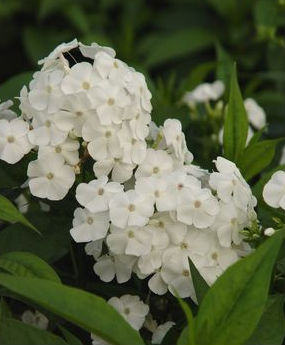 Phlox paniculata
Phlox paniculata
Tall garden phlox are an all-time garden favorite. Did your grandparents have them in their garden? It’s very likely! Phlox have been populating American gardens for decades. In mid-summer phlox will bloom forth in colors that range from white to hues of pink, purple and every shade in between, including bi-color petals.
Phlox are one of the most long-lived perennials, growing to 3-4′ tall in slightly moist compost rich soil (Phlox don’t mind clay soil). The site should be in full sun or sun with a little shade, air circulation is important for phlox so it helps them to thin out a few stems from time to time. Deadhead to extend the bloom period.
Try ‘David’, pictured at left, or go for some color with ‘Red Caribbean’ which is a gorgeous pink with red centers. Many varieties are fragrant offering you one of the most classic beauties of the flower world. You’ll gain some butterflies and a great cut flower for your garden too.
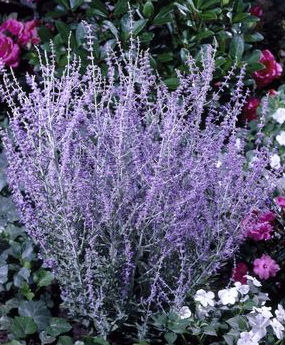
Perovskia
Russian Sage looks as if it fell out of an impressionist painting. Airy and ethereal describes this lavender/blue member of the mint family with stems reaching upward from silvery gray foliage. Sage wants full sun and well-draining, even dry, soil in order to really be at its best. Combined with flowers such as yellow coreopsis, orange coneflowers or red roses, you can create one of the most eye-catching color combinations possible.
Traditional Russian sage grows to 3-4′ while some newer compact cultivars have shortened the plant up a bit. ‘Little Spire’ tops out at about 2′ while ‘Lacey Blue’ stays in the 12-18″ range.
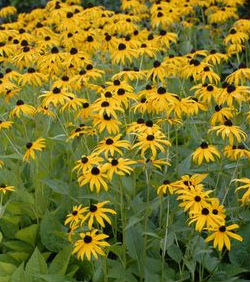 Rudbeckia
Rudbeckia
Also known as Black-Eyed Susan, Rudbeckia fulgida, falls into the easy to grow category. Well known for its happy show of blooms beginning in mid-summer and extending to fall.
Rudbeckia does well in average soil as long as its well-draining, tolerates dry and hot conditions and even puts up with a bit of light shade, making it an easy choice for the garden. Growing to 3′ tall, ‘Goldsturm’ is not only prolific and attractive, but attracts butterflies to the garden and multiplies to fill a larger area.

